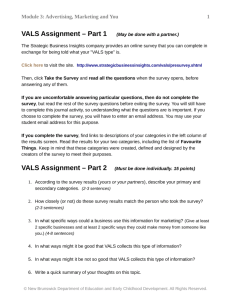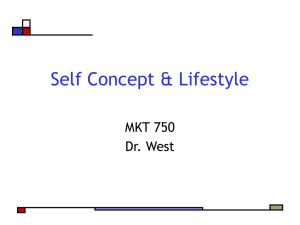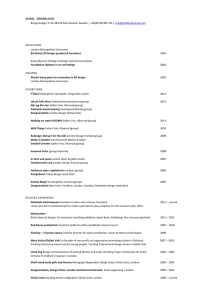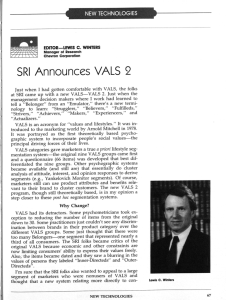Judith's VALS survey result
advertisement
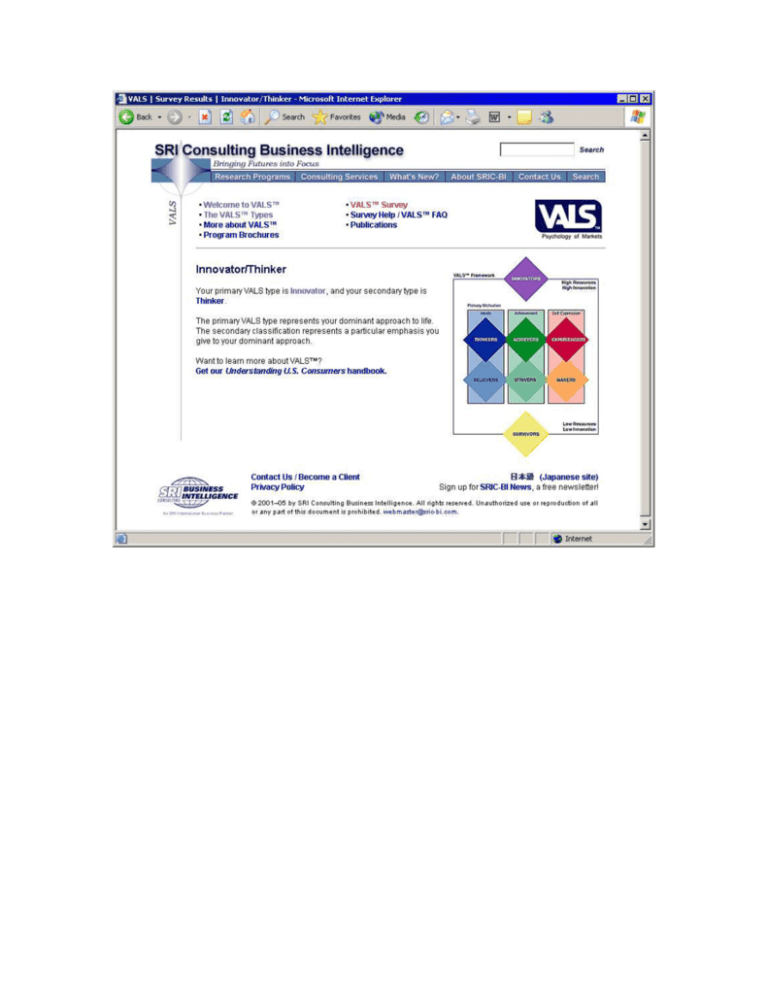
1. What does VALS stand for? The first VALS system was based on social values, and VALS was an acronym for Values and Lifestyles. The current VALS system is based on psychological traits instead of social values, so we dropped "Values and Lifestyles" but retained the VALS brand. 2. What is VALS used for? Marketers use VALS to understand why consumers make the choices they do. The more marketers know about the target, the better they can design messages that resonate with the target. By using VALS to understand the motivations that stimulate consumer behavior (such as buying a product or participating in a loyalty program), marketers increase their chance of cutting through today's advertising clutter. 3. What are primary and secondary VALS types? An individual's primary VALS type is the group with which the individual has the strongest affinity—the group with which the individual has the most characteristics in common. An individual's secondary VALS type is the group that the individual is next most like. Secondary VALS types can expand the number of groups in the system and enable marketers to target smaller, more niche groups. 4. Why did you change three of the VALS Segments' names? We changed the VALS segment names to make them more intuitive and easier to remember. We now call Actualizers "Innovators" to highlight that these consumers are at the leading edge of change. Fulfilleds are now "Thinkers" because one of their distinguishing characteristics is their rational approach to decision making. Strugglers are now "Survivors" because although they have limited material resources, they do not stress about their limitations but live complacently within their means. 5. Why did you change "self-orientations" to "primary motivations"? We made this change to emphasize that VALS, unlike demographic segmentations and other marketing tools, measures the psychological drivers of consumer behavior. Thinkers and Believers are primarily motivated by ideals. Achievers and Strivers are primarily motivated by achievement. Experiencers and Makers are primarily motivated by self-expression. 6. The VALS questionnaire is so short. How do you know about product, service, and activity preferences by VALS segment if you ask only these questions? These questions are not the only ones that we ask. The VALS questionnaire on our Web site is our "VALSlocation battery." Its purpose is to identify a person's VALS type. We gather consumer product, service, and activity data by integrating the VALS questionnaire into larger custom or syndicated questionnaires. We integrate the VALS questionnaire into Consumer Financial Decisions's MacroMonitor questionnaire, giving us a source of detailed financial behavior by VALS types. We also integrate it into various clientspecific questionnaires, and Mediamark Research Inc.'s (MRI's) Survey of American Consumers. 7. How did the VALS questionnaire develop? The VALS questionnaire is based on a $1.5 million development effort and several large national surveys of consumer opinion that SRI International, a nonprofit research organization in Menlo Park, California, conducted between 1987 and 1992. These surveys allowed SRI to identify the specific attitudes that have had a strong correlation with a large range of consumer preferences in products and media. The current questionnaire is the third version based on this kind of extensive empirical research. 8. What is the idea behind the VALS questionnaire? The motivations and demographic characteristics that this questionnaire asks about are very strong predictors of a variety of consumer preferences in products, services, and media. The main advantage, therefore, is predictive power: To understand consumers' individual preferences and likely reactions to new products or services, we can ask this relatively short list of questions in place of a very long list of questions about current product, activity, and media choices. 9. How will my answers to the questionnaire be used? Any information that links your responses to your identity (for example, through your IP address or e-mail address) is strictly confidential. Thus, the connection between who you are and what you enter will never be sold, given away, or otherwise revealed. The only way we will use the information you enter is in aggregation, in which case the identities of the respondents will be anonymous. 10. So why are you providing this questionnaire to the public? We plan to use the survey results to understand the Internet population better and to guide the creation of new, Internet-specific research tools. In particular, we are investigating how psychographic systems such as VALS can help online users identify content of interest and how content providers can understand their potential audiences better. The other reason we are providing this questionnaire—actually, the primary reason—is that we think that doing so is an interesting use of the Web and that people might enjoy it. 11. Some of the questions in the VALS questionnaire seem overly simplistic. Why? The questions measure very basic individual motivations with as little confusion as possible. Therefore, we refer to commonplace, concrete activities or interests, and we ask the questions in straightforward and simple terms. 12. Why do many of the questions in the VALS questionnaire seem to ask the same thing? Asking repeatedly about an issue provides a more accurate measure of opinions about that issue. For instance, a single item permits an opinion to fall into only 1 of the 4 numbered response categories; with two items, an opinion may fall into 1 of 16 categories (four times four). Asking about the same issue in different ways also reduces the possibility that respondents may misunderstand what we want to know. 13. Are you aware that some of the questions in the VALS questionnaire are politically incorrect? We are measuring how people think, not prescribing how they should think. Thus, the statements refer to possible attitudes of the person taking the questionnaire, not to the possible attributes or attitudes of other people. If someone finds a question objectionable, he or she should register his or her disagreement by selecting the "mostly disagree" option. 14. What good is the VALS questionnaire anyway? Using questionnaires such as the VALS questionnaire is one of the primary ways that businesses come to understand consumers' individual preferences, needs, and interests. Imagine, for instance, that a company must design a new kind of software program, knowing only that most of its potential users are between 30 and 40 years old, with a college education. VALS adds the human side of the equation: preferences for control or freedom, tradition or novelty, information or stimulation, hands-on activity or intellectual abstractions. 15. What are the weaknesses of the VALS questionnaire? People can always provide false answers to this kind of questionnaire, out of malice or curiosity. The more accurate the responses, however, the more trustworthy the results. Added problems arise through the misinterpretations or ambiguities inherent in the use of words. Because no conversation or interactivity exists to clear up possible misinterpretations or ambiguities, the VALS questionnaire asks more than one question about each topic. Finally, words themselves characterize only a small portion of human experience. Future tests may be more sensory and more interactive, much like a multimedia game. 16. Where can I find information about iVALS™? iVALS™ is no longer part of the VALS family of products because it has become less applicable as the Internet has evolved. Given the explosive growth of the Internet user population, looking at Internet behavior through the VALS system is appropriate and sufficient. The VALS types exhibit distinct behaviors on the Internet just as they do in traditional consumer marketplaces. Please feel free to take our traditional VALS survey. 17. How can I learn more about VALS? In response to overwhelming demand, the VALS team has published a special handbook—Understanding U.S. Consumers—for anyone who is interested in learning a little bit more about the psychological attributes and demographics that underlie consumer decision making. You can purchase Understanding U.S. Consumers for $50.00 (USD) plus shipping charges. The VALS program periodically makes special materials available to academic professionals. Future materials may include educational videos, presentations, and reports. Please let us know if you would like us to contact you about future products by adding your name to our VALS for Education mailing list. Subscribers will be notified periodically by e-mail about new VALS materials designed for academics. We also welcome any questions, inquiries, or comments about VALS at vals@sric-bi.com.
